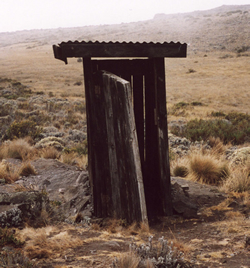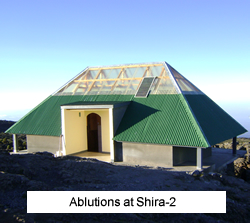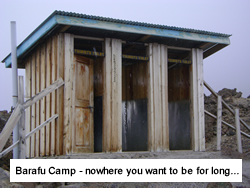Toilets on Kilimanjaro
 There is great romance in planning and setting off to climb this great mountain. Less romantic are some of the fundamental human functions that need to be taken care of in a natural environment through which thousands of sundry people tramp annually.
There is great romance in planning and setting off to climb this great mountain. Less romantic are some of the fundamental human functions that need to be taken care of in a natural environment through which thousands of sundry people tramp annually.
For each person who signs up for a commercial climb at least three accompanying support staff are included. Once the practical business of climbing the mountain begins the down-to-earth implications of this volume of traffic with regards to where these people all ‘go’ becomes no small matter.
Standards vary from camp to camp…
Depending on the trail you choose the nature and standard of the toilets on offer vary enormously. I have noticed that the higher the altitude the less inviting are the facilities. This probably has much to do with the degree to which one’s energy diminishes at altitude, leading those unfortunate souls charged with the responsibility of maintaining these structures losing interest at altitudes above 12000ft.
The best ablution facilities can be found along the highly commercial routes such as Marangu, and to a lesser extent Machame. The standard of service available at Shira 2 Camp, for example, at the point where Lemosho Route and Machame Route merge is very high. However, far more commonly, services are offered in crudely built and shallowly dug ‘long drop’ potties that are heavily utilized and that offer a less-that-delightful aroma if your porter happens to site your tent downwind.
Facilities are circulated as much as possible…
 The good news is that these amenities are regularly circulated so that the build-up of atmospheric toxins is ameliorated somewhat. There are also usually quite a few of them available at any one camp, so one can be selective about which among the many to visit.
The good news is that these amenities are regularly circulated so that the build-up of atmospheric toxins is ameliorated somewhat. There are also usually quite a few of them available at any one camp, so one can be selective about which among the many to visit.
Whatt is unavoidable, however, is that they are almost exclusively squat toilets and a degree of dexterity and accuracy are required to effectively use them. Sadly evidence abounds to suggest that these skills are surprisingly rare in the climb fraternity.
The Barafu bog consipracy…
The worst concentration of toilets I have found are at Barafu Camp, although I invite comparison from anyone who cares to disagree.
Barafu enjoys a number of signature disadvantages as a camp. It consists of a bleak and waterless ridge that was clearly chosen with more practical than aesthetic considerations in mind. It is the point at which a number of trails merge, and being as there is but one summit, and this is the last staging point for a good many climb parties, it is crowded, messy and it stinks.
It is evident that the local national parks authority is trying as best it can to keep ahead of the demand, and things could definitely be worse, but there is no pleasure in satisfying your fundamental needs here.
Bring your own if you can afford it…
 Most of the higher-end outfitters nowadays offer a version of the portable sailing toilets that are carried skyward up the mountain on the heads of local porters. For women in particular these devises are a godsend and the extra few dollars they cost are definitely worthwhile.
Most of the higher-end outfitters nowadays offer a version of the portable sailing toilets that are carried skyward up the mountain on the heads of local porters. For women in particular these devises are a godsend and the extra few dollars they cost are definitely worthwhile.
It is easy to overlook this when considering price options for your climb, but remember when the day comes that you have to stand in the freezing wind, toilet-roll in hand, looking at a dozen possibilities, each one less inviting than the last, you will without doubt appreciate the extra expense.
Or keep it bottled up until you get to lower altitude…
The good news is that the Kilimanjaro National Park Authority (KINAPA) is gradually working towards a general improvement. There are always going to be remote camps at high altitude where the practicalities of camp maintenance are very difficult, but certain entrepots…for example Shira 2, Mweka Camp and the hutted camps along Marangu … offer a much higher standard of facility that for most punctuates and relieves the overall unpleasantness of that signature windswept hut on a cold and lonely mountainside.